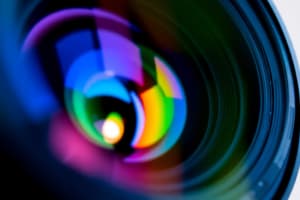Podcast
Questions and Answers
What is the primary function of a lens in optical systems?
What is the primary function of a lens in optical systems?
- To absorb all light
- To magnify images
- To create light
- To refract light (correct)
Which type of lens is thicker at the center than at the edges?
Which type of lens is thicker at the center than at the edges?
- Concave lens
- Convex lens (correct)
- Cylindrical lens
- Bifocal lens
In what situation would a concave lens be most useful?
In what situation would a concave lens be most useful?
- To correct nearsightedness (correct)
- To magnify small objects
- To correct farsightedness
- To focus sunlight
Which statement accurately describes how lenses interact with light?
Which statement accurately describes how lenses interact with light?
What determines the focal length of a lens?
What determines the focal length of a lens?
Flashcards
Lens Test in Science
Lens Test in Science
An experiment or activity to evaluate the properties and functions of lenses in science.
Lenses
Lenses
Transparent objects with curved surfaces that refract light.
Refraction
Refraction
The bending of light as it passes from one medium to another.
Optical properties
Optical properties
Signup and view all the flashcards
Science 1
Science 1
Signup and view all the flashcards
Study Notes
Lens Types
- Different types of lenses exist, each with unique properties and applications.
- Convex lenses: These lenses are thicker in the middle than at the edges. They converge light rays, causing them to meet at a single point.
- Concave lenses: These lenses are thinner in the middle than at the edges. They diverge light rays, spreading them out.
Key Properties of Lenses
- Focal length (f): The distance between the focal point and the lens.
- Focal point (F): The point where parallel light rays converge (for convex lenses) or appear to diverge from (for concave lenses) after passing through the lens.
- Principal axis: An imaginary line passing through the center of the lens perpendicular to the lens surfaces.
- Optical center (O): The geometric center of the lens, located on the principal axis.
Image Formation by Lenses
- When objects are placed at different positions relative to a lens, images are formed with varying characteristics (e.g., real or virtual, magnified or diminished).
- Real images: Images formed by the actual intersection of light rays. These images can be projected onto a screen.
- Virtual images: Images formed by the apparent intersection of light rays that extend behind the lens. These images cannot be projected onto a screen.
- Magnification (M): The ratio of the height of the image to the height of the object. Magnification can be positive or negative.
Ray Diagrams for Lenses
- Ray diagrams are used to trace the path of light rays through a lens to determine the location and size of the image.
- Important rays:
- A ray parallel to the principal axis passes through the focal point (for convex lenses) or appears to come from the focal point (for concave lenses).
- A ray passing through the optical center continues in a straight line.
- A ray passing through the focal point refracts parallel to the principal axis (for convex lenses).
Lens Formulas
- Thin lens equation: 1/p + 1/q = 1/f, where
- p is the object distance
- q is the image distance
- f is the focal length.
- Magnification formula: M = -q/p
Applications of Lenses
- Cameras: Lenses are used to focus light from the scene onto the film or sensor.
- Microscopes: Multiple lenses are used to magnify small objects.
- Telescopes: Lenses are used to collect and focus light from distant objects.
- Eyeglasses/corrective lenses: Lenses are used to correct vision problems like nearsightedness and farsightedness.
Studying That Suits You
Use AI to generate personalized quizzes and flashcards to suit your learning preferences.




